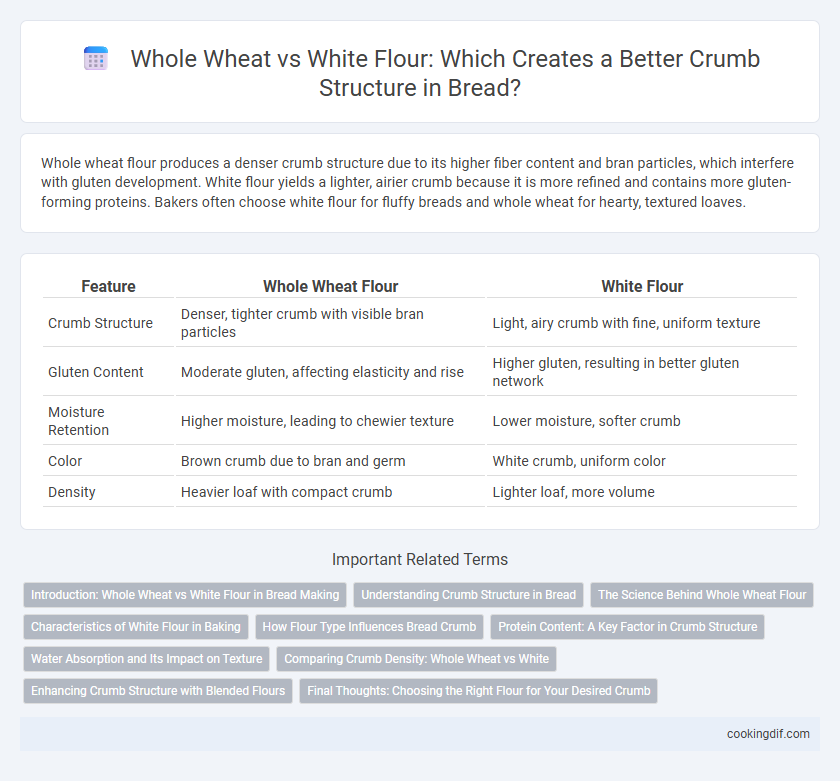Whole wheat flour produces a denser crumb structure due to its higher fiber content and bran particles, which interfere with gluten development. White flour yields a lighter, airier crumb because it is more refined and contains more gluten-forming proteins. Bakers often choose white flour for fluffy breads and whole wheat for hearty, textured loaves.
Table of Comparison
| Feature | Whole Wheat Flour | White Flour |
|---|---|---|
| Crumb Structure | Denser, tighter crumb with visible bran particles | Light, airy crumb with fine, uniform texture |
| Gluten Content | Moderate gluten, affecting elasticity and rise | Higher gluten, resulting in better gluten network |
| Moisture Retention | Higher moisture, leading to chewier texture | Lower moisture, softer crumb |
| Color | Brown crumb due to bran and germ | White crumb, uniform color |
| Density | Heavier loaf with compact crumb | Lighter loaf, more volume |
Introduction: Whole Wheat vs White Flour in Bread Making
Whole wheat flour contains the entire wheat kernel, including bran, germ, and endosperm, which contributes to a denser crumb structure due to the higher fiber content and reduced gluten development compared to white flour. White flour, refined by removing bran and germ, produces a lighter, airier crumb with a finer texture, ideal for soft bread varieties. Understanding these structural differences is crucial for bakers aiming to achieve specific bread textures and nutritional profiles.
Understanding Crumb Structure in Bread
Whole wheat flour produces a denser crumb structure in bread due to its higher bran and germ content, which interferes with gluten formation. White flour, refined and stripped of bran, creates a lighter, more open crumb by allowing better gluten development and gas retention. Analyzing crumb texture reveals that whole wheat breads have a coarser, chewier bite, whereas white flour breads exhibit a softer, airier crumb ideal for delicate sandwiches.
The Science Behind Whole Wheat Flour
Whole wheat flour contains bran, germ, and endosperm, which contribute to a denser crumb structure compared to white flour that is made only from the endosperm. The higher fiber content in whole wheat flour absorbs more water, resulting in a more hydrated dough and tighter crumb. Enzymes and natural oils in whole wheat also affect gluten development, producing a chewier texture and richer flavor profile in the bread.
Characteristics of White Flour in Baking
White flour, characterized by its fine texture and high gluten content, produces a soft and tender crumb with a tight structure in baked goods. It undergoes extensive refining, which removes bran and germ, resulting in a lighter color and smoother dough that rises consistently. Its lower fiber content compared to whole wheat allows for a more delicate crumb, ideal for cakes, pastries, and bread requiring a fluffy texture.
How Flour Type Influences Bread Crumb
Whole wheat flour contains bran and germ that create a denser bread crumb with a coarser texture compared to the softer, lighter crumb produced by refined white flour lacking these components. The higher protein content in white flour contributes to better gluten development, resulting in improved gas retention and a more open, airy crumb structure. In contrast, the presence of fiber and oils in whole wheat limits gluten network formation, yielding a tighter, chewier crumb ideal for hearty bread varieties.
Protein Content: A Key Factor in Crumb Structure
Whole wheat flour contains higher protein levels, typically around 13-15%, compared to white flour's 10-12%, significantly impacting crumb structure by promoting stronger gluten development. This increased protein content results in a denser, chewier crumb with more complex texture and enhanced moisture retention in whole wheat bread. In contrast, lower protein white flour produces a lighter, softer crumb with larger air pockets, ideal for tender bread varieties.
Water Absorption and Its Impact on Texture
Whole wheat flour absorbs more water than white flour due to its higher fiber content, resulting in a denser and more moist crumb structure. This increased water absorption enhances the bread's chewiness and shelf life while producing a coarser texture compared to the lighter, more airy crumb typical of white flour. Understanding these hydration differences is critical for bakers aiming to optimize dough consistency and achieve desired textural qualities in whole wheat breads.
Comparing Crumb Density: Whole Wheat vs White
Whole wheat flour produces a denser crumb structure due to its higher fiber content and bran particles, which interfere with gluten development and trap less air during fermentation. White flour, refined and stripped of bran and germ, allows for more gluten formation, resulting in a lighter, airier crumb with larger, more uniform holes. The increased crumb density in whole wheat bread affects texture and chewiness, making it more substantial compared to the softer crumb of white bread.
Enhancing Crumb Structure with Blended Flours
Blending whole wheat and white flour enhances crumb structure by balancing the dense, nutrient-rich profile of whole wheat with the light, airy texture of white flour. The higher protein content in whole wheat flour contributes to a more developed gluten network, while white flour provides softness and finer crumb texture. This combination results in bread with improved moisture retention, softness, and a more open, tender crumb.
Final Thoughts: Choosing the Right Flour for Your Desired Crumb
Whole wheat flour creates a denser crumb due to its higher bran and fiber content, which absorbs more water and inhibits gluten development. White flour, particularly bread flour, yields a lighter, airier crumb with better elasticity and volume, making it ideal for softer bread textures. Selecting the right flour depends on whether the goal is a hearty, rustic crumb or a tender, open crumb structure.
Whole Wheat vs White Flour for crumb structure Infographic

 cookingdif.com
cookingdif.com